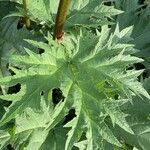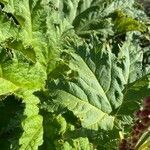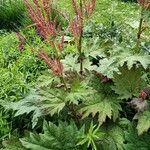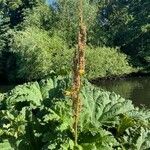Herbs large, 1.5-2 m tall, stout. Rhizomes and roots stout. Stem hollow, sulcate, subglabrous or muricate on nodes. Petiole of basal leaf terete, ca. as long as blade, densely papilliferous; leaf blade large, ca. as long as wide, 40-60 cm, abaxially densely pubescent, adaxially sulcate to papilliferous, basal veins 5, base cordate, palmately divided into pinnatisect lobes, apex acuminate or narrowly acute. Stem leaves smaller above; ocrea large, to 15 cm, outside muricate. Panicle large; branches connivent, densely pubescent. Pedicel 2-2.5 mm, jointed below middle. Flowers small. Tepals 6, purple-red, rarely yellow-white, outer 3 elliptic to orbicular, smaller, 1-1.5 mm. Stamens not exceeding perianth. Ovary rhomboid-ovoid; style slightly deflexed; stigma inflated. Fruit oblong-ellipsoid to oblong, 8-9 × 7-7.5 mm, both ends retuse; wings ca. 2.5 mm wide, with longitudinal veins near margin. Seeds brown-black, broadly ovoid. Fl. Jun, fr. Aug.
More
A plant that keeps growing from year to year. It grows 1.5-2.4 m high and spreads 1.5 m wide. It has a thick rhizome. The leaf stalks are thick and fleshy. The leaves have deep lobes and teeth. They are 100 cm wide. The young leaves are purplish-red. The flowers are in fluffy panicles. They flowers are small and pink. They grow on tall stems. The fruit have 3 wings.
Scrub and rocky places and by streams, at elevations from 2,500-4,000 metres. Slopes and valleys; at elevations from 1,500-4,400 metres in western and northern China.
More
It is a temperate plant. It grows between 1,500-4,400 m above sea level. It suits hardiness zones 6-9. In Sichuan and Yunnan.




